MUGHAL ARCHITECTURE
All the early Mughal Rulers except Aurangzeb were great bui1ders. With the coming of the Mughals, Indian architecture was greatly influenced by Persian styles. The Mughals constructed excellent mausoleums, mosques, forts, gardens and cities. The Mughal buildings show a uniform pattern both in structure and character.
The main characteristic features of Mughal architecture are the bulbous domes, the slender minarets with cupolas at the four corners, large halls, massive vaulted gateways and delicate ornamentation.
The few mosques and palaces built by Babar and Humayun are not of much architectural significance
Sher Shah of the Sur Dynasty who ruled over the Kingdom of the Mughals after driving Humayun out of the country was not only a great administrator but a lover of art also. He built several forts, tombs and mosques. The monuments of Sher Shah are a continuation of the Lodi style. The mausoleums are octagonal in plan and have verandahs around them, surmounted by huge domes. The verandahs have three smaller domes on each side.
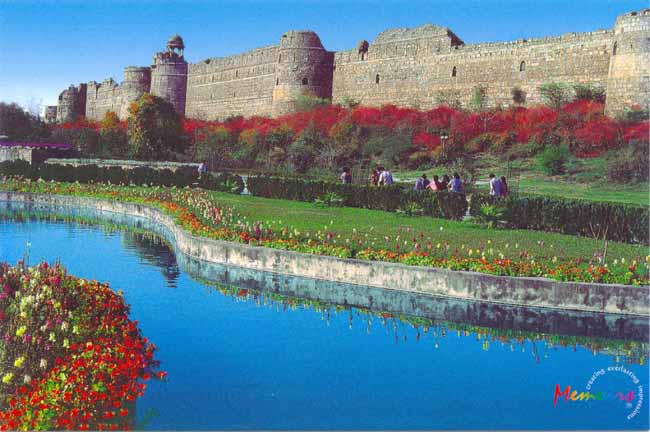
Purana Quila (Old Fort), Delhi
Sher Shah built the Purana Quila in Delhi. Started by him, it was completed by Humayun. Built of red and buff sand-stone, it is ornamented with black and white marble and coloured tiles. A beautiful mosque inside the Quila with ornamental arches, decorative panels, geometrical designs and inscriptions is an example of the development of architecture and ornamentation during Sher Shah's reign.
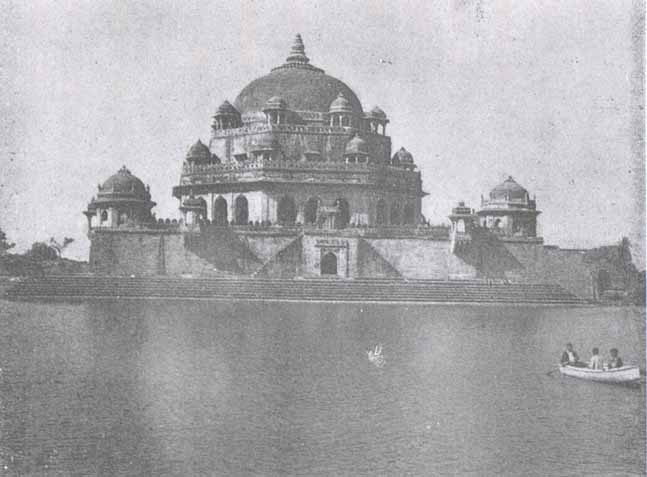
Sher Shah's tomb, Sasaram
Sher Shah's tomb at Sasaram in Bihar built in 1549 is in the centre of a large square tank and rises al 46 metres high. It is a two storey construction on a terraced platform. The upper terrace has pillared domes and the two storeys above have a pillared kiosk at the four corners. The base of the large central dome has thirty two sides. The tomb is decorated with coloured tiles, very few of which remain now. Entrance to the tomb is through a domed structure.
Mughal architecture begins with Akbar who showed his passion for building by planning and constructing splendid edifices. During his reign Mughal architecture took on new forms. Akbar made free use of both Hindu and Persian styles. The use of red sandstone inlaid with white marble and painted designs on walls and ceiling are the salient features of Akbar's buildings.
Akbar constructed numerous forts, towers, palaces, mosques, mausoleums and gateways. A structure of note built during his reign is Humayun's Tomb in Delhi.
Humayun's Tomb
Humayun’s tomb was built by his widow Haji Begum in 1565 A.D. in Delhi in 1569A.D., fourteen years after his death. The mausoleum stands in the centre of a square enclosed garden. The garden is divided and sub-divided into squares, typical of Mughal gardens. The lofty double storeyed structure is built on a huge high platform terrace which has a row of calls with arched openings. The central chamber is octagonal in shape and contains the tomb. Each side of the mausoleum has a large arched alcove in the centre with smaller ones on either side. It has a high marble double dome in the centre and pillared kiosks with cupolas surrounding it. Built of red sandstone with an inlay of black, white and yellow marble it presents an imposing picture. Planned by a Persian architect and constructed by Indian workers, it is a combination of both Persian and Indian styles of architecture. Entrance to the mausoleum is through two double storeyed gateways.

Humayun's Tomb
(Picture courtesy Archaeological Survey of India)
Agra Fort
A greater part of the fort at Agra was constructed by Akbar starting in 1565 AD and completed it in 1574 A.D. Situated on the bank of the river Jamuna, it is a massive and grand structure. The special feature of this fort is the 2.5 kms. long and 21 metres high circuitous wall of solid red sand stone. The stones are linked with iron rings so close that not even a hair can pass through. The entrance to the fort is through two gateways. The main entrance known as Delhi Gate was the ceremonial entrance to the fort. The other smaller gateway is called the Hathi Pol or Elephant Gate because of the two huge elephants on either side of the gate and was meant for private use.
The Delhi Gate entrance archway is flanked by two double storeyed octagonal bastions crowned by octagonal domed kiosks. A balcony separates the two storeys. The structure above the balcony has arched recesses. The gateway is decorated with beautiful panels of coloured tiles and marble inlay work.
The fort is surrounded by a deep moat. The fort formerly contained numerous buildings of red sand stone but these were later demolished in the reign of Shah Jehan who constructed marble pavilions instead. Some of the important buildings inside the fort are the Jahangiri Mahal built for Jahangir and his family, the Moti Masjid, and Mena Bazaars. The Jehangiri Mahal is an impressive structure and has a courtyard surrounded by double-storeyed halls and rooms. The corbel brackets, doorways and the chajja above them are profusely carved.
The elaborate architecture of the brackets seems to be an imitation of wood work. The planning and construction of the fort show that Rajput architectural styles were freely adopted.
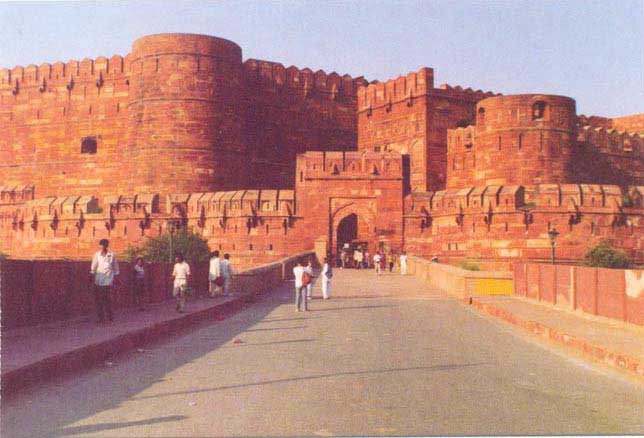
Agra Fort
(Picture courtesy Archaeological Survey of India)
Fatehpur Sikri
Akbar’s greatest architectural achievement was the construction of Fatehpur Sikri, his Capital City near Agra. The construction pf the walled city was started in 1569 A.D. and completed in 1574 A.D. contained some of the most beautiful buildings – both religious and secular which testify to the Emperor’s aim of achieving social, political and religious integration. The religious edifices worth mentioning are the Jami Masjid and Salim Chisti’s Tomb. The tomb built in 1571 A.D. in the corner of the mosque compound is a square marble chamber with a verandah. The cenotaph has an exquisitely designed lattice screen around it.
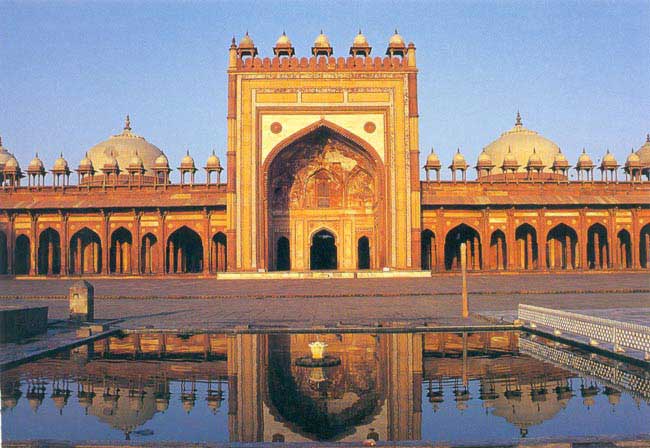
Jami Masjid, Fatehpur Sikri
(Picture courtesy Archaeological Survey of India)
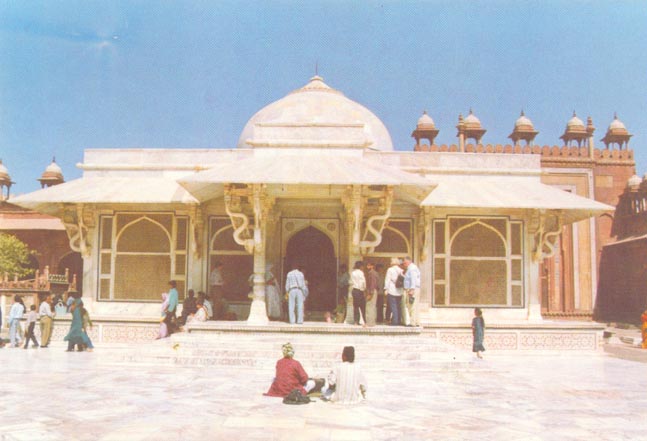
Tomb of Sheikh Salim Chisti, Fatehpur Sikri
(Picture courtesy Archaeological Survey of India)
The secular ones include Jodh Bai’s palace, the Panch Mahal, the Diwan-i-khas and the Buland Darwaza. Jodha Bai's palace is a large building consisting of rooms on all four sides of a courtyard. The centre part and four corners of the building are doubled storeyed. A small chapel attached has niches in the wakks for idols. The panch Mahal is a five stored structure, each storey smaller in size as they go up, the last one being only a kiosk.
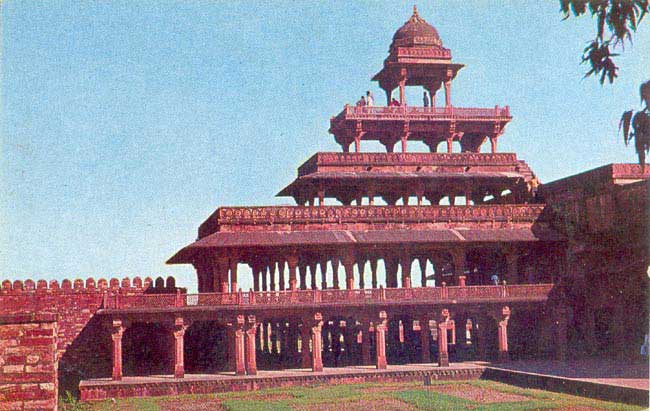
Panch Mahal, Fatehpur Sikri
(Picture courtesy Archaeological Survey of India)
The Diwani Khas, an outstanding structure was meant for the Emperor to sit in audience with his ministers and listen to disputes and discussions. A novel structure, it is a large hall with a giant monolithic pillars in the centre with a circular railed platform on top like a cup which is supported by a circular array of beautifully carved brackets. From the Central platform branch out four diagonal railed galleries symbolizing Akbar’s supremacy over his dominions. The gallery is continued on all four sides of the hall. The audience sat in the galleries and in the hall below giving it the effect of a two-storey building. Sitting in the centre, Akbar heard discourses and discussions on religions.
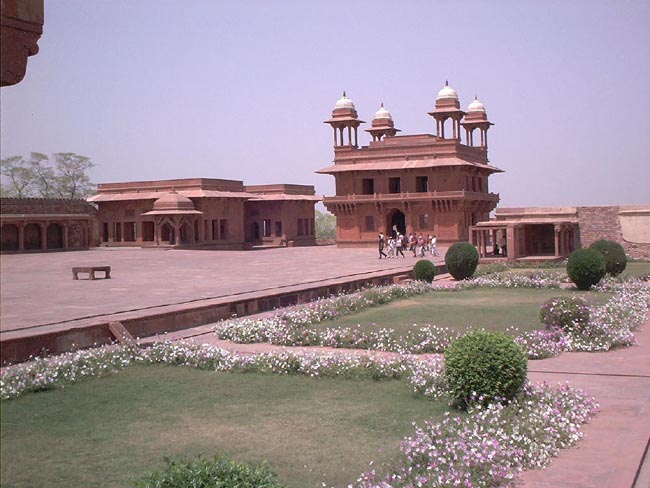
Diwani Khas
(Picture courtesy Great Mirror)
Buland Darwaza
A magnificent gateway was added later in 1571-72 to commemorate his conquest of Gujarat. Built of red sand stone and marble it is said to be the “most perfect architectural achievement in the whole of India". A flight of steps lead to the gateway which is about 53 metres in height and 39 metres in width. Entrance is through a huge arched domed recess. A broad rectangular strip bordering the archway has calligraphic inscriptions on it. At the corners are slender turrets. The beautiful perforated parapet and the row of kiosks with cupolas add to the dignity of the monument. An inscription on the gateway testifies to Akbar’s religious toleration.

Buland Darwaza, Fatehour Sikri, Agra
(Picture courtesy Archaeological Survey of India)
Jehangir though a lover of art was fond of natural beauty and so devoted his time to the laying of beautiful gardens such as the Shalimar and Nishat Bagh in Srinagar, Kashmir and to miniature paintings. Out of the few of his constructions of note are Akbar's tomb at Sikandra and the tomb of his father-in-law Itmad-ud-Daula both near Agra
Akbar's Tomb, Sikandra
The Mausoleum of Akbar at Sikandra near Agra was started by Akbar and completed by his son Jahangir in 1612 A.D. who changed the original design of his father. Designed on the model of a Buddhist Vihara, it is set in the centre of a square garden. The enclosure wall on each side has a gateway. The main gateway has four white marble minarets in the four corners. The Mausoleum has five terraces, rising from the basement, one above the other, diminishing in size as they ascend. The red sand-stone entrance gateway is the largest and is richly decorated with inlaid coloured stone work. With its charming proportions, it is by itself a work of art.
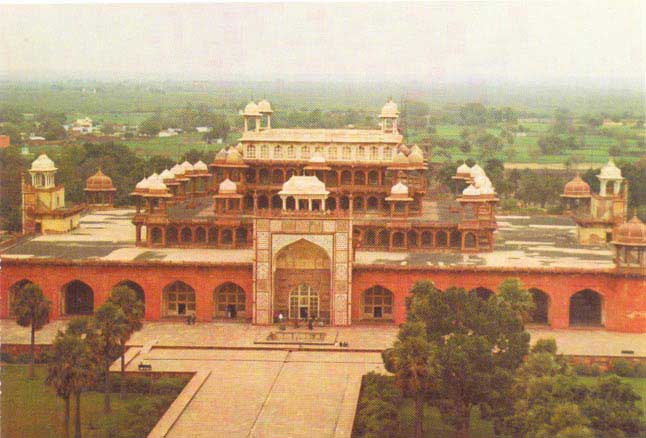
Akbar's Tomb, Sikandra
(Picture courtesy Archaeological Survey of India)
Itmad-Ud-Daula’s Tomb:
The Mausoleum of Itmad-ud-Daula, the revenue minister of Jahangir and Nur Jehan’s father was built in Agra on the banks of the Jumuna. Started by Jahangir it was completed by Nur Jehan in 1628 A.D. A small rectangular structure in white marble, inlaid with semi-precious stones and coloured glass, it is a delicate and beautiful piece of architecture. It is the first pure marble monument and differs from the typical massive, red sand-stone structures of earlier Mughals. Situated in a garden amidst fountains, it has a square lower storey with four minarets in the four corners. A traceried pavilion forms the second storey. A central chamber inside contains the tombs and is surrounded by an enclosed verandah. A jewel in marble-“there is no other building like it in the entire range of Mughal Architecture”.
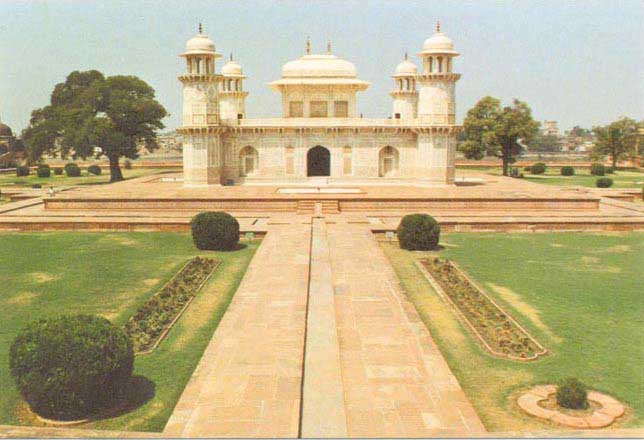
Itmad-Ud-Daula’s Tomb, Agra
(Picture courtesy Archaeological Survey of India)
Shah Jehan, the most famous of the Mughal builders had a passion for building. His reign marks the construction of numerous palaces, forts, mosques and gardens. His buildings are marked by the quality feminity, grace and elegance. They do not show the masculinity of Akbar's solid red sand-stone constructions. Mughal architecture reached the peaks of excellence during this reign. The main characteristics of his buildings are - the use of delicately carved white marble richly decorated with pietra dura or inlay of coloured stones and calligraphy in black marble. Some of his outstanding works are the Moti Masjid or Pearl Mosque in Agra Fort and the Taj Mahal, the Red fort in Delhi with the Diwan-i-Am and Diwan-i-Khas, the Jami Masjid in Delhi and the mausoleum of Jehangir in Shahdara, Lahore (in Pakistan).
Jama Masjid, Delhi
The Jama Masjid in Delhi is the largest mosque in India and was built between 1650-1656A.D. It is constructed on a high platform and approached by a flight of steps on three sides. The main entrance is a double storeyed gateway and leads to a vast square courtyard which is enclosed by pillared corridors. The prayer hall, rectangular in plan has a facade of eleven arches. The high central arch is flanked by tall slender minarets with cupolas. White marble panels with inscriptions frame the arches. Three domes with alternate black and white marble stripes surmount the prayer hall. On the eastern corners, stand two tapering four storeyed minarets.
Red Fort
Soon after laying the foundation or his new Capital city of Shahjehanabad Shah Jchan started construction of the red sandstone Red Fort or Lal Quila in 1638 A.D. on the banks of the river Jumuna. The fort took nearly nine years to complete. Within the walled city, the fortress is in the shape of a rectangle 900 metres by 550 metres. The rampart walls are about 34 metres high. A moat surrounds the rampart. Two of the five gateways of the fort are three storeyed structures flanked by octagonal towers. These are the Lahori Gate and the Delhi Gate. Figures of two huge elephants flank the Delhi Gate. The main entrance to the fort is through the Lahori Gate. A covered passage with shops on either side leads to the palaces inside the fort. Barracks for soldiers, audience halls, horse and elephant stables, and ornamental gardens are other features of the fort.
Some of the beautiful buildings are the Diwan-i-Am, Diwan-i-Khas, Moti Mahal, Hira Mahal and Rang Mahal, the latter three, all halls decorated with pietro dura and patterns in gold and colour and floors paved with marble slabs. The Moti Masjid was added later in 1654 A.D. and is an excellent specimen of the balance and rhythm maintained in Mughal constructions.
The Diwan-i-Am (Hall of Public Audience) is an arched pillared durbar hall. A white marble throne, embellished with coloured inlay work stands under a marble canopy. Below the throne is a marble dais inlaid with semi-precious stones. Behind the throne, the wall has beautiful panels of flowers and birds in coloured inlay work.
The Diwan-i-Khas (Hall of Private Audience) is a rectangular central hall with aisles of arches and painted pillars. The four corners of the roof have pillars with chhatris on them. The walls have the famous verses of Amir Khusro which says that “If there is paradise on earth it is here”
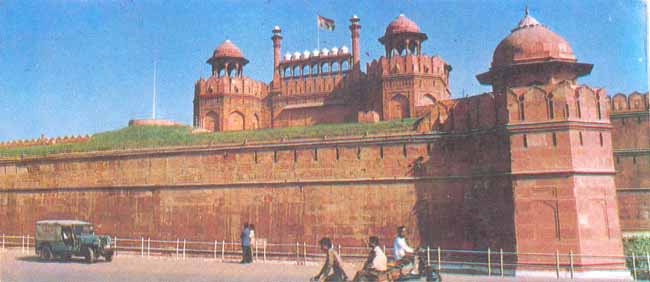
Red Fort, Delhi
Taj Mahal
The Taj Mahal in Agra, a dream in white marble was built by Shah Jehan as a memorial to his beloved wife Mumtaz Begum. Built on the banks of the river Jumna, it was started in 1632 A.D. and took 22 years to complete. Marble from Makrana and precious stones from different parts of the world were used in its construction. Planned by Isa, a Persian architect it is a masterpiece of architecture. The Taj is situated in the centre of a high marble terrace. A marble minaret of four storeys stands on each of the four corners of the terrace. The minarets are crowned with domes. The main structure is a square. A huge, vaulted recess with smaller arched recesses in two storeys on either side make up the facade of the building on all sides. An octagonal hall with an exquisite perforated marble screen contains the cenotaphs of Mumtaz and Shah Jehan. The vaulted ceiling is crowned in the centre by a large bulbous dome which tapers off into a foliated crest. Around the dome are four cupolas. The surface of the walls – exterior and interior and the cenotaphs are beautifully decorated with pietra dura, floral and geometrical designs. Borders of inscriptions decorate the main archways.
A Mosque on the west and a corresponding structure on the east in red sand-stone complete the effect of symmetry. Situated in a large enclosed rectangular garden with fountains, ornamental pools and water-courses, entrance to the Taj is by a majestic gateway.
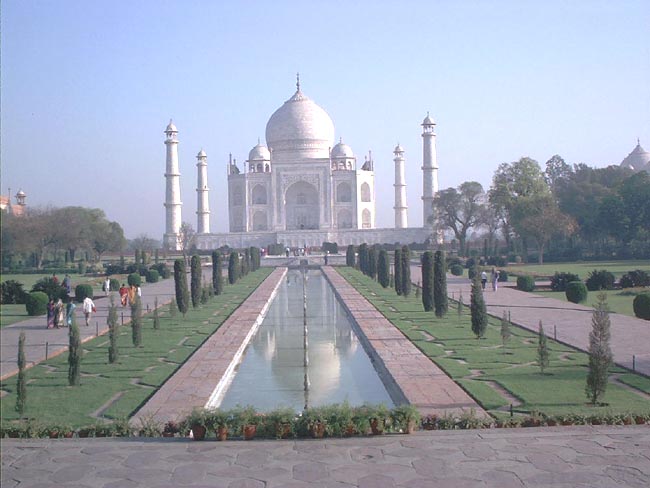
Taj Mahal, Agra
(Picture courtesy Archaeological Survey of India)
Bibi Ka Maqbara
Aurangzeb being a puritan did not encourage art in any form. Architecture and fine Arts declined during his reign never to come up again during Mughal rule. One of the very few buildings of this period worth mentioning is the mausoleum of his wife, Rabia-Ud-Daurani erected in 1679 A.D. in Aurangabad (Deccan) by her son. A poor replica of the Taj Mahal and half its size, it shows the extent to which art had declined. Its noteworthy features are the latticed octagonal white marble screen, which encloses the tombs and the beaten brass doors with floral panels and borders.
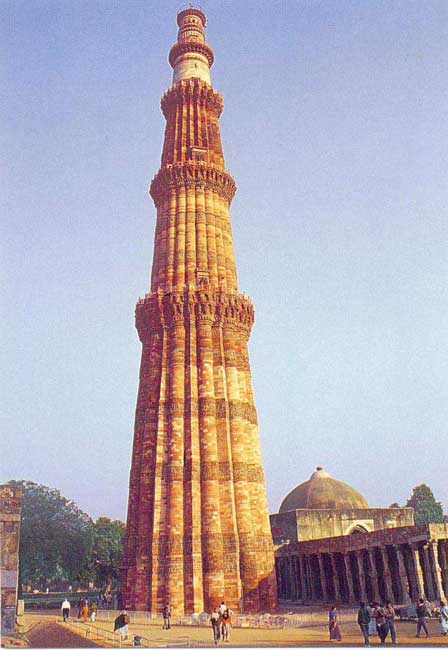
MUSLIM ARCHITECTURE
The Muslim rulers of India contributed greatly to the evolution and development of a new style of art and architecture in India. The Muslims before coming into India had their own characteristic style of art as is seen in their mosques and palaces. Contact with the already established, highly developed Hindu architectural styles led to a fusion and synthesis of art styles resulting in the emergence of the Indo-Islamic style of art and architecture. The period of the Turko-Afghans saw the development of this style, different from region to region, assimilating local styles and characteristics.
The two systems of art namely Hindu and Muslim are basically different in technique. The salient features of Muslim architecture are large buildings, open courtyards, mosques, bulbous domes, tall and slender minarets, arched gateways made beautiful with geometric designs and calligraphic inscriptions, use of coloured stone and glazed tiles, while the Hindu structures have lefty pyramidal shikharas, dark shrines, rich sculptural mouldings, decorations on the walls and pillars.
Muslim structures can be classified under two types – religious and secular. Religious structures are mosques, tombs and mausoleums. Secular ones are forts, palaces, gateways and gardens.
The important features of a mosque are – an open courtyard with a pillared verandah around, a sanctuary near the wall facing Mecca, a pulpit and a minaret above the wall to summon people to prayer. The sanctuary has a large dome above it.
The mausoleums constructed over the tombs of the dead are beautiful monuments with vaulted halls, lofty domes, underground clambers where the graves are located and separate mosques. All these are located in an extensive enclosure.
The Muslim conquerors employed Indian masons and materials for the construction of their buildings which factor was responsible for the introduction of Hindu ideas and designs in Muslim buildings. The Delhi style of architecture seen in the constructions in Delhi and surrounding areas is to be seen in the buildings of the Slave rulers. Famous among these is the Qutub Minar and the Quwat-Ul-Islam mosque near it in Delhi.
The Qutub Minar
The Qutub Minar is both a tower of victory and a tower for the Muazzim to call the muslims to prayer. The foundation was laid by the Slave ruler Qutub-Ud-Din Aibeck in 1199 AD and completed by his son-in-law and successor Iltutmish in 1230A.D. Built of red and buff sand stone, it is 72.5 meters high. It originally consisted of four storeys decreasing in size as they go up. The fifth storey was added later. Circular in plan, each storey is separated by a protecting balcony supported on brackets. Each storey has a different plan. The lowest has alternate angular and rounded flutings; the second has all rounded flutings and the third has all angular flutings. The decorative inscriptional bands enhance the beauty of the storeys. The diameter of the tower at the base is 14.32 metres and about 2.75 metres at the top. It has a spiral staircase of 379 steps and is the highest tower in India.
Close to the Qutub Minar is the Quwat-Ul-Islams Mosque and the famous Iron Pillar of the 4th century A.D. set up as a dhwajastambha of Vishnu. Allauddin Khilji is said to have enlarged the mosque and added the Alai Darwaza.

Qutab Minar
I recently found many useful information in your website especially this blog page. Among the lots of comments on your articles. Thanks for sharing.
ReplyDeletearchitects in Pakistan